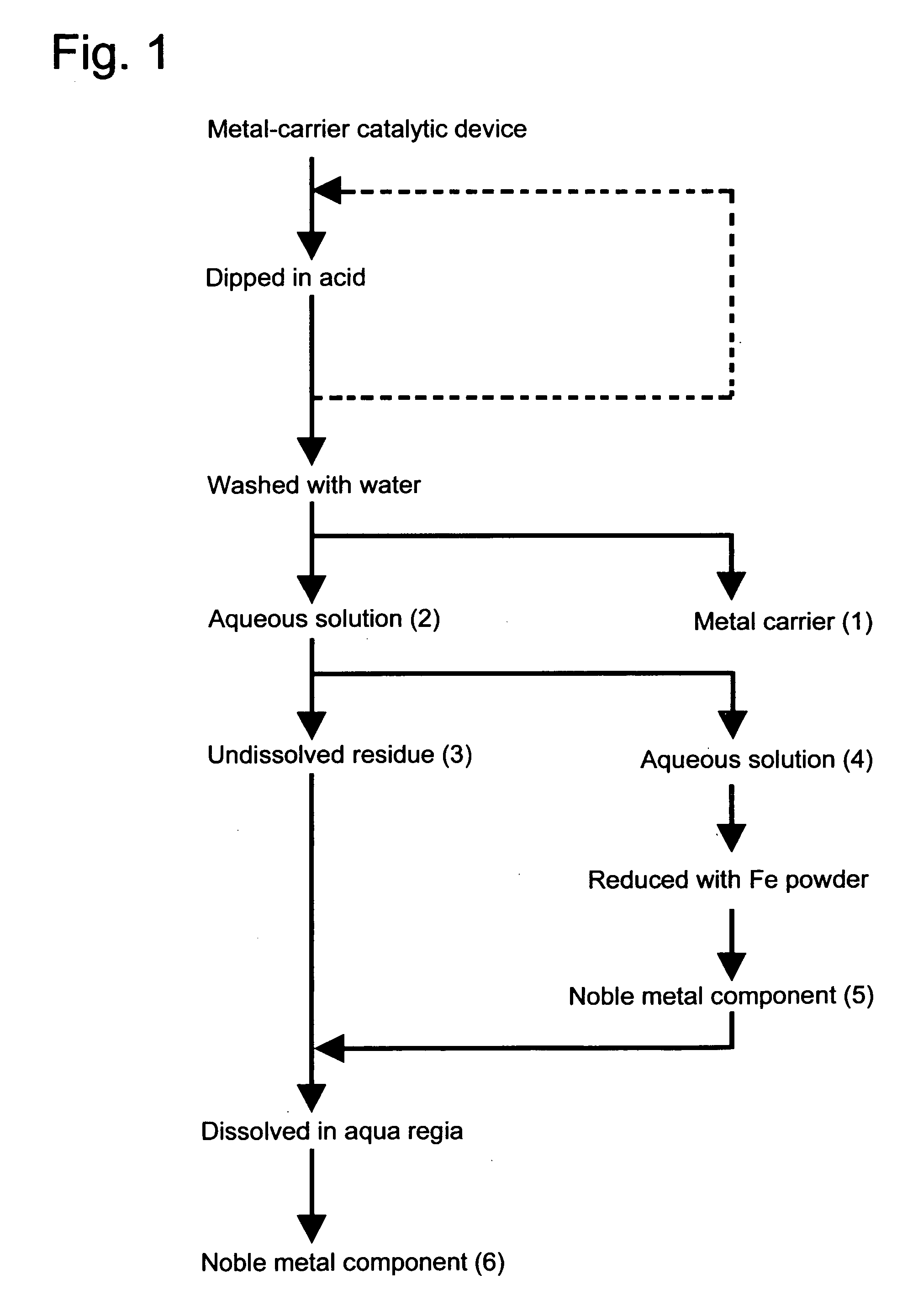Method for recovering noble metals from metallic carrier catalytic device
- Summary
- Abstract
- Description
- Claims
- Application Information
AI Technical Summary
Benefits of technology
Problems solved by technology
Method used
Image
Examples
referential example 1
[0025] A heat-resistant stainless steel honeycomb body having a diameter of 900 mm and a height of 1260 mm (hereinafter referred to as metallic carrier; volume: 800 cc) was coated with 140 g of activated alumina, was burned, and was then made to support 0.3 g of platinum (Pt), 2.3 g of palladium (Pd) and 0.3 g of rhodium (Rh) per one metallic carrier, and, thus, a metallic carrier catalytic device was manufactured.
example 1
[0026] In accordance .with the flow sheet as shown in FIG. 1, the metallic carrier catalytic device as manufactured in Referential Example 1 was dipped in an aqueous solution which contained 20% by weight of sulfuric acid and 2% by weight of nitric acid, and was thus treated at 80° C. for five hours. After left to cool down, the metallic carrier (1) was taken from said aqueous solution, and was washed with water. Thus obtained wash liquid and the above-mentioned aqueous solution were put together to give an aqueous solution (2) which contained undissolved residue. The recovered metallic carrier had the same appearance as before coated with activated alumina, and showed no sign of dissolution at all.
[0027] Aqueous solution (2) was separated, by filtration, into undissolved residue (3) and aqueous solution (4). Aqueous solution (4) was subjected to a reduction treatment by the addition of 10 g of iron (Fe) powder, and, thus, noble metal (Pt, Pd, Rh) component (5) was deposited and re...
example 2
[0028] In accordance with the flow sheet as shown in FIG. 1, the metallic carrier catalytic device as manufactured in Referential Example 1 was dipped in an aqueous solution which contained 20% by weight of sulfuric acid and 2% by weight of nitric acid, and was thus treated at 80° C. for five hours. Metallic carrier (1) was then taken from said aqueous solution, and was subsequently dipped in a newly prepared aqueous solution which contained 20% by weight of sulfuric acid and 2% by weight of nitric acid, and was thus treated again at 80° C. for five hours. After left to cool down, the metallic carrier was washed with water. Thus obtained wash liquid and the above-mentioned aqueous solution were put together to give an aqueous solution (2) which contained undissolved residue. The recovered metallic carrier had the same appearance as before coated with activated alumina, and showed no sign of dissolution at all.
[0029] Aqueous solution (2) was separated, by filtration, into undissolve...
PUM
| Property | Measurement | Unit |
|---|---|---|
| Temperature | aaaaa | aaaaa |
| Temperature | aaaaa | aaaaa |
| Temperature | aaaaa | aaaaa |
Abstract
Description
Claims
Application Information
 Login to View More
Login to View More - R&D
- Intellectual Property
- Life Sciences
- Materials
- Tech Scout
- Unparalleled Data Quality
- Higher Quality Content
- 60% Fewer Hallucinations
Browse by: Latest US Patents, China's latest patents, Technical Efficacy Thesaurus, Application Domain, Technology Topic, Popular Technical Reports.
© 2025 PatSnap. All rights reserved.Legal|Privacy policy|Modern Slavery Act Transparency Statement|Sitemap|About US| Contact US: help@patsnap.com


